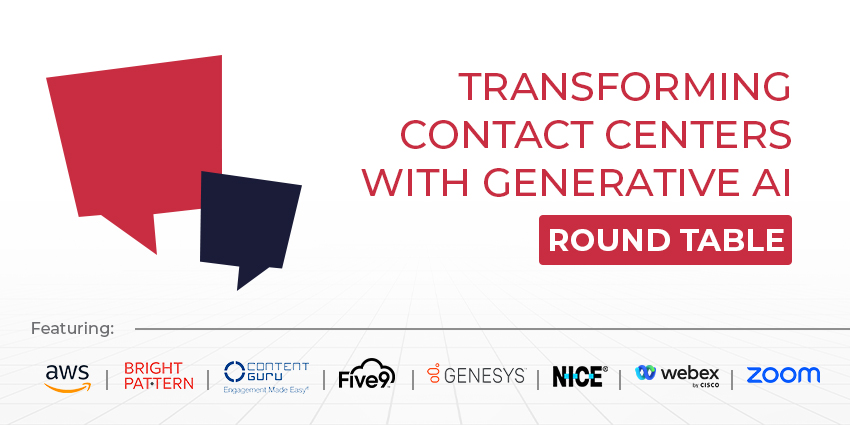The customer experience space is awash with generative AI (GenAI) innovation.
Whether it’s supporting supervisors, agents, or customers, lots of use cases catch the eye.
Yet, it’s not all sunshine and roses, as DPD’s GenAI chatbot disaster recently highlighted.
As such, we’ve pulled together some of the best minds in contact center tech to discuss the biggest wins and risks of GenAI implementations. They are:
- Michael McCloskey, CEO of Bright Pattern
- Lorrissa Horton, SVP/GM and Chief Product Officer at Webex
- Michael Wallace, Americas Solution Architecture Practice for CX at AWS
- Martin Taylor, Co-Founder & Deputy CEO of Content Guru
- Jonathan Rosenberg, CTO and Head of AI at Five9
- Brett Weigl, SVP and GM of Digital, AI, and Journey Orchestration at Genesys
- Elizabeth Tobey, Head of Marketing, Digital Solutions at NICE / Lauren Maschio, Product Marketing Manager at NICE.
- Ben Neo, Head of Contact Center and CX Sales, EMEA at Zoom
Below, each expert also shares a prediction on how GenAI will impact the contact center space over the coming year.
Which GenAI Use Cases Are Contact Centers Starting to Implement?
Auto-Summarizations & Insight Generation
Maschio: Generative AI has changed the way contact centers summarize their interactions. It is a key ingredient to automating the process of what has traditionally been a manual, time-consuming task.
Indeed, contact centers can now instantly generate objective and digestible post-interaction summaries with the relevant context for the next agent. Those summarizations include customer sentiment and intent insights.
As a result, the next time a customer interacts with a brand’s customer service department, their experience will be connected to their previous interactions, allowing agents to never miss a beat and help facilitate a seamless interaction.
Finally, it saves CX organizations valuable time and money, reducing post-interaction work and average handle time through automation.
Pinpointing CX Improvement and Automation Opportunities
Rosenberg: Five9 anticipates more brands will harness Gen AI technologies to aggregate data for a clear picture of recurring issues and areas for improvement to enhance the services offered by human agents.
However, it’s crucial that CX leaders call AI what it is, or they risk breaking customer trust. Attempting to pass an automated response off as a human, especially in high-emotion scenarios, is a mistake. Instead, companies need to strike a balance between human and automated services.
GenAI-Augmented Live Agents
Neo: Zoom introduced AI Companion this year, a GenAI assistant that helps Contact Center agents complete tasks quicker, thus improving their engagements with end customers.
Such tasks include auto summaries to reduce wrap-up time, suggested next-step actions, live transcription, sentiment analysis to ensure you steer the conversation positively to help the customer, and many more features.
GenAI-Augmented Virtual Agents & Live Coaching
Wallace: Customers are very interested in using generative AI to augment virtual agents.
The early ask was to “replace agents” with generative AI. Yet, as customers have learned more about capabilities and risks, we see more of our customers using GenAI to augment and empower bots to understand and process ambiguous information where they previously could not do so.
Generative AI also surfaces more valuable insight into your CX performance and analytics. With the introduction of AI-powered contact summaries and Agent Scorecards, contact centers may access better insights into CX trends and agent behaviors.
Task Automation
Weigl: GenAI can assist customer-facing employees in working more efficiently through task automation and – in some cases – fully take over certain tasks, data lookups, and other time-consuming elements of customer care delivery.
The technology also provides employees with more timely customer context and can help them find an answer quickly by making suggestions and delivering answers proactively.
Lately, administrators, supervisors, workforce planners, and quality managers can all benefit from GenAI-powered assistants that help to interpret data, spot areas for employee improvement and learning, and automate routine tasks.
Customer Intent Analysis
McCloskey: GenAI makes it easier to monitor customer intent. As such, contact centers can more easily determine why customers are calling and what keywords/topics are the main contact drivers.
Such data is critical for contact centers to spot their demand drivers and take targeted actions – either via process fixes or conversational AI – to lower contact volumes and customer effort.
Moreover, that data is excellent to funnel to execs so they can see where their service costs are coming from. They may then offer more support in overcoming customer journey point points.
Supervisor Support & Generative Audio
Horton: GenAI helps deliver insights to supervisors on how they can support an agent’s well-being.
Stress and burnout rates are especially high among agents in contact centers, which see twice as much turnover as any other profession.
Cisco has developed new GenAI capabilities to improve agents’ well-being by enabling automated breaks, such as a Thrive Reset, and real-time coaching after difficult interactions.
Also, contact centers can deploy technology to enable smoother audio quality, even when caller bandwidth is low. Webex offers this with its new Webex AI Codec.
GenAI IVR Transformations
Taylor: Although GenAI use cases are applicable across all channels, the biggest efficiency gains typically come during voice interactions.
Indeed, GenAI can make ‘wait time’ productive, gathering information before a customer interacts with an agent – such as who is calling and the nature of their query – to segment and prioritize calls.
GenAI can “listen” during the call and populate the agent’s screen with relevant information from approved sources. This prevents the agent from needing to look up the data manually, which could otherwise form 10-20 percent of the interaction, and reduces the time required to train agents.
Share a GenAI in the Contact Center Security Risk, and Note How Contact Centers Can Avoid It.
Adversarial Attacks
Neo: One security risk associated with implementing GenAI in contact centers is the potential vulnerability to adversarial attacks on AI models.
These attacks effectively manipulate input data to deceive AI systems, leading to incorrect or unintended outputs.
When it comes to contact centers, attackers may attempt to manipulate voice recordings or generate synthetic voices to mimic legitimate customers and gain unauthorized access to systems protected by voice biometrics.
By staying vigilant, regularly updating models, and employing additional security measures, contact centers can minimize the risk of adversarial attacks and ensure the robustness of their GenAI applications.
Moreover, ongoing monitoring and auditing of AI systems can help identify and address potential security vulnerabilities as they emerge.
McCloskey: Generative AI’s ability to imitate human communication in almost any style prompts serious concerns about automated social engineering attacks.
Preying on users’ existing susceptibilities to such attacks can result in disclosing sensitive data or engaging them in security-compromising behaviors.
GenAI Hallucinations
Rosenberg: The main risk to be aware of is AI hallucinations, which is the tendency for generative AI applications to make up information that is just not true.
Human-in-the-loop techniques and data aggregation – which combines the output of the LLM across many conversations – help mitigate this risk.
For example, AI summary technologies will use these LLMs to summarize every customer interaction, but live agents should review them before submitting the summary to the case history.
Still, this saves a lot of time for agents, thus producing a great ROI, but also minimizes the risk of hallucinations by involving human intelligence.
Such an approach must underpin all AI strategies in 2024. Then, GenAI will empower businesses to create more personal experiences at scale while improving reliability at the same time.
Wallace: The most common concern we hear is: “What about hallucinations?”
So, how do we avoid them? By limiting the LLM’s ability to access incorrect data, we can control what it will respond with.
For instance, with Amazon Q in Connect, we give Q access to the customer knowledge base, and answers can only be formed from that knowledge base.
The process (Retrieval Augmented Generation) allows users to update and re-train the information the model can use while limiting the model to information the user defines as safe.
Data Security
Horton: One of the key areas I recommend customers ask vendors about is: Where does my data go when I am leveraging GenAI, and how do I ensure it is safe?
While the benefits of GenAI in the contact center are immense, remember that these capabilities are not foolproof.
As such, contact centers must ensure their systems only leverage data individuals already have permission to access based on that specific data source’s privacy and security rules.
In addition, there’s always the risk that an AI model produces inaccurate suggested responses or summarization notes, so agents must play an active role in reviewing AI-generated content.
Deepfakes
Weigl: Generative AI enables fraudsters to create content that trips up conventional identification and verification (ID&V) techniques.
Thankfully, fraud detection technology will advance in lockstep to counter risks like deepfakes.
Also, multi-authentication factors will be as useful to prevent ID theft and impersonation. An excellent example is using a text confirmation code routine in addition to voice print.
Moreover, contact centers will use additional predictive signals to detect fraud, given that stolen identity can mean bad actors pass through ID&V in some circumstances.
For instance, communications from an unusual location might trigger a signal even if all other factors check out.
Loss of Data Sovereignty
Taylor: The biggest security risk concerns where LLMs process information.
When people were first introduced to GenAI tools such as ChatGPT, they unknowingly gave personal information, such as their name or date of birth. That digital footprint is permanently etched into the fabric of the AI and used to inform later generations of GenAI models.
To mitigate the security risks GenAI poses, focus on building and testing versions of GenAI that can be driven and deployed in controlled environments.
For instance, consider the private cloud to ensure data sovereignty and mitigate risks.
Compliance Breaches
Tobey: CX organizations must ensure compliance with all data protection regulations regarding their AI usage. That requires bringing on new skilled professionals who have expertise in AI development, data science, and ethical considerations.
Such individuals will be key to understanding the AI that is being used and monitoring AI use for any potential security concerns.
Additionally, it’s equally important for organizations to choose purpose-built, domain-specific AI for CX. This type of AI was built specifically for contact centers, including all proper guardrails.
Indeed, it is the only option for contact centers to responsibly and effectively use AI for their CX.
What More Can We Expect from GenAI in 2024?
The Virtual Assistant Concept Evolves
Wallace: GenAI will continue to aid contact center teams as a creative assistant.
Yet, expect to see the extension of the “assistant” concept – as it enters other contact center development areas beyond the agent and supervisor desktop.
For example, the assistant could create an entire IVR script, along with the necessary configuration.
In addition, vendors have so far only scratched the surface of what generative AI can do from an analytics standpoint.

Soon, GenAI may analyze and suggest changes in contact handling methods based on patterns and trends, automatically suggesting the creation of a virtual agent based on analysis of repeated call types.
Of course, as GenAI strategies mature, more capabilities will bubble to the service – perhaps including virtual agent interactions that utilize GenAI image classification to help with warranty claims or product support.
Fully Automated, But Strategic Dialogues Rise
Taylor: The mainstream adopters of GenAI will likely support, rather than replace, human agents who remain in command.
Towards the end of this year, an increased proliferation of fully automated dialogs in customer support will become much more normalized.

An enhanced chatbot may also give in-depth answers in the least critical environments possible, where it doesn’t matter if the AI is wrong.
Moreover, these technologies will likely make their mark on smaller organizations with less to lose, less brand capital at stake, and no critical infrastructure.
Bespoke GenAI Models Come In-Vogue
Rosenberg: Five9 is looking to reduce entry barriers for voice and digital virtual agents in the CX space and AI applications that utilize natural language – including self-service, call routing, next-best action, and more.
Generative AI will allow us to democratize our AI applications for customer service, bringing them to many more customers.
With it, Five9 will reduce – if not completely eliminate – the complex process of building and training bespoke AI models. This training process prevents AI apps from being ubiquitously deployed.

With ChatGPT, AI can more accurately understand voice and language than ever before without requiring hand-tuned models for each business.
As a result, that last barrier to the widespread adoption of AI in communications services – including customer service – crumbles.
Custom Contact Center Automations Surges
Weigl: Teams will start to utilize GenAI to build automations. For instance, a GenAI-powered assistant could help a contact center analyst note repetitive tasks agents perform for a particular type of contact reason.
GenAI can also write the code to automate the tasks and integrate the systems necessary to reduce cost and effort.
Next, data analysts will benefit from interpretive capabilities, coupled with predictive AI that spots trends and raises alerts when necessary.
The contact center will also become more multilingual through GenAI-powered machine translation.

Lastly, multi-mode GenAI-powered features – for instance, interpreting images sent as part of a customer service interaction – will become more common.
Look out for the first fully automated GenAI-driven interactions in the final quarter of 2024.
Domain-Specific GenAI Prevails
Tobey: 2024 will bring a greater separation between good and bad AI – and purpose-built CX AI will become the most sought-after.
More pointedly, these will be domain-specific AI for CX, built with proper guardrails and trained on rich historical CX data to ensure appropriate and relevant AI outputs.

Organizations will quickly realize this is the only way to succeed with AI for customer experience.
After all, generic AI trained on the open internet will not cut it, and organizations that use this will risk their reputation. Instead, businesses must invest in talent with AI expertise to discern which CX AI is right for them.
The Self-Learning Contact Center Emerges

Horton: Going forward, AI will advance to the point where the self-learning contact center can learn what the top issues are and generate a solution to manage those concerns, either through a virtual agent or improved intent routing.
Moreover, it will pre-emptively address a customer’s question or concern before they even have the chance to reach out to the service team.
GenAI Bolsters Conversational Analytics
Neo: GenAI will evolve and create more personalized customer interactions by leveraging advanced predictive analytics and deep customer behavior analysis. This will result in highly tailored product recommendations, content, and services.
GenAI will also become better at understanding and responding to human emotions. That may enable more emotionally intelligent virtual agents to empathize with customers and adapt their communication style accordingly.

Later in the year will come the emergence of multimodal AI models, with the tech going beyond text, allowing users to mix and match content based on text, audio, image, and video for prompting and generating new content.
Such an approach involves combining data, such as images, text, and speech, with advanced algorithms to make predictions and generate outcomes.
Automated Quality Scoring Becomes the Norm

McCloskey: GenAI will provide automated scoring on each interaction so that companies can implement continuous process improvement measures in an automated fashion and replace legacy algorithms in functions such as workforce management.
Moreover, it will help in self-service to answer queries and provide deep understanding and assistance to agents and customers.
Missed our recent roundtable dissecting the CPaaS space? Check it out here: CPaaS In Customer Experience: Examples, Trends, & Providers








